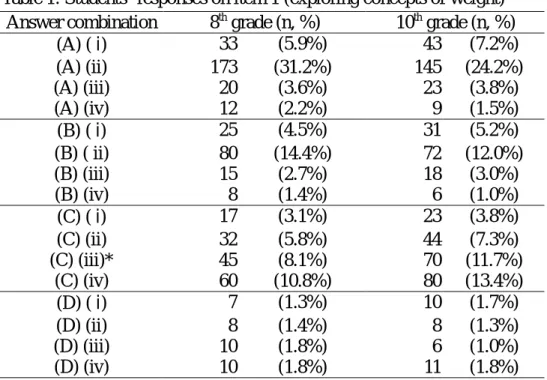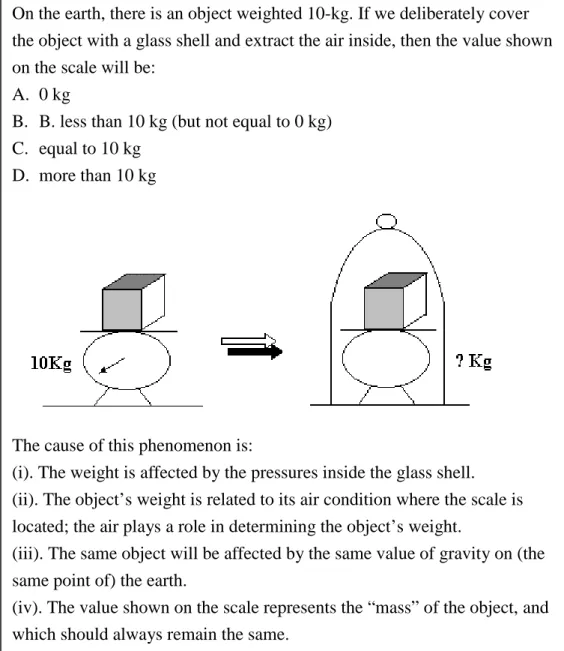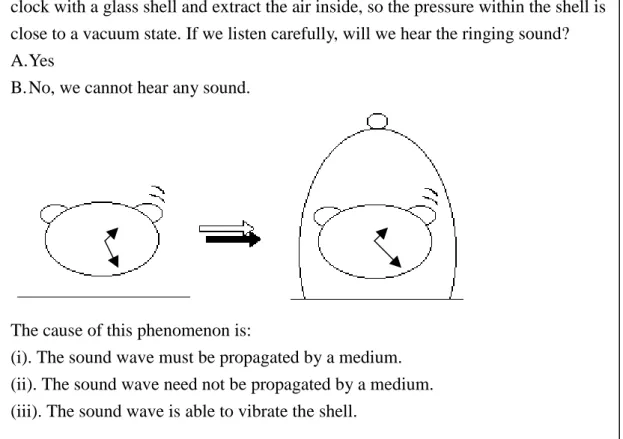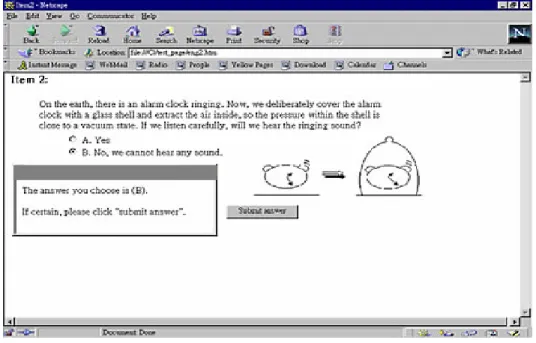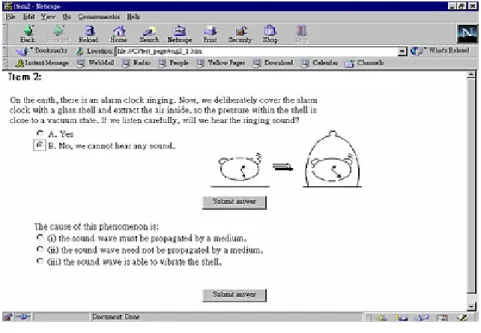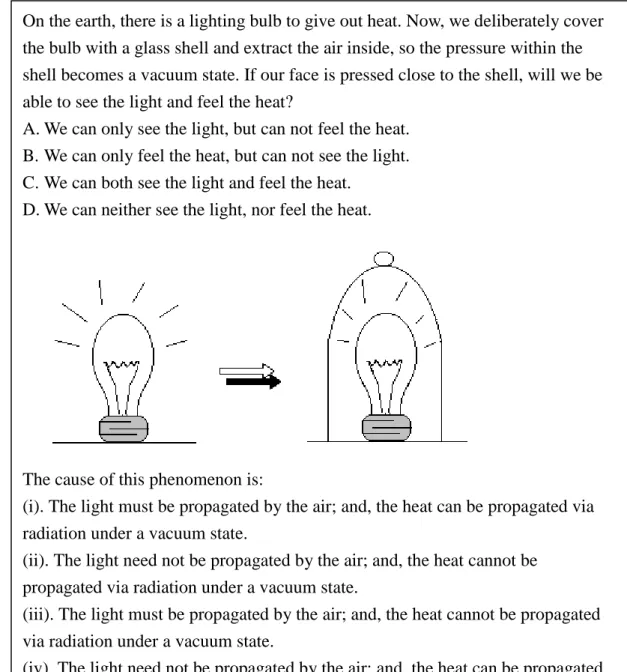Diagnosing students’ alter native conceptions in science through a networ ked two-tier test system
Chin-Chung Tsai and Chien Chou
Abstr act
This study described an attempt on developing a networked two-tier test system. Two-tier test is a two-level multiple-choice question that diagnoses students’ alternative conceptions in science. Three networked two-tier test items were presented in this study. Five hundred fifty-five 8th graders and five hundred ninety-nine 10th
graders in Taiwan, then, were asked to answer these items on-line.
Students’ answers suggested that students’ alternative conceptions might be retained even after formal instruction about relevant conceptions. Further development of the two-tier test system will mainly focus on designing appropriate feedback and
guidance that help students overcome their alternative conceptions. In this way, the networked two-tier test system is not only a diagnostic tool, but also an effective instructional tool.
Chin-Chung Tsai holds a B.Sc. in physics from National Taiwan Normal University. He received a Master of Education degree from Harvard University and a Master of Science degree from Teachers College, Columbia University. He completed his doctoral study also at Teachers College, Columbia University, 1996. He is currently an Associate Professor at National Chiao Tung University, Taiwan. His research interests deal largely with constructivism, science education and Internet-based instruction. Chien Chou received her M.S. Ed. Degree in Instructional Systems Technology in 1986 from Indiana University, Bloomington, and the Ph.D. degree in Instructional Design and Technology from the Ohio State University at Columbus in 1990. Since 1993 she has been with National Chiao Tung University, Taiwan, where she is currently a Professor in the Center for Teacher Education. Her research interests include network-based learning, multimedia and hypermedia instruction, and psychology and behavior in cyberspace. Address for correspondence: Center for Teacher Education, National Chiao Tung University, 1001 Ta Hsueh Rd., Hsinchu 300, Taiwan, e-mail: cctsai@cc.nctu.edu.tw, cchou@cc.nctu.edu.tw
Diagnosing students’ alter native conceptions in science through a networ ked two-tier test system
Introduction
In recent 25 years, many science educators believe that students’ knowledge in domain-specific areas plays a more important role than their general cognitive ability or underlying logical structures on conceptual learning of science (Driver and Easley, 1978). Consequently, science education researchers have widely surveyed students’ knowledge in various domains, known as students’“misconceptions” or “alternative conceptions” (Wandersee, Mintzes and Novak, 1994). Researchers have developed methods to explore student alternative conceptions, for instance, interviews (Bell, 1995; Posner and Gertzog, 1982) and concept maps (Novak and Gowin, 1984). However, these methods often require additional training and amounts of time to conduct, analyze, and to make interpretation (Ruiz-Primo and Shavelson, 1996). Two-tier test, a pencil and paper test in a multiple-choice format, hence, is proposed by science educators to diagnose students’ alternative conceptions (Treagust, 1988; Odom and Barrow, 1995). The use of two-tier test allows teachers to not only understand students’ scientifically incorrect ideas, but also explore students’
reasoning behind these ideas. Moreover, it is easy for teachers to assess alternative conceptions of a larger sample of students in a more efficient and relatively
straightforward method. It is recently widely used in science education research (Christianson and Fisher, 1999; Voska and Heikkinen, 2000).
With rapid development of internet technology, the two-tier test can be implemented on a web site to further achieve wider accessibility for students and practicing teachers. The main purpose of this paper will describe an attempt on developing a networked two-tier test system.
Two-tier test
The two-tier test is a two-level question presented in a multiple-choice format. The item presented in Figure 1 shows a sample that explores students’ alternative conceptions about weight. The first tier assesses students’ descriptive knowledge about the phenomenon, that is, the weight in a vacuum condition on the earth. The second tier explores students’ reasons for their choice made in the first tier. Hence, the second tier investigates students’ explanatory knowledge or so-called their “mental models.” Since the two-tier test is in a multiple-choice format, it is much easier for teachers to score or interpret students’ responses. In this way, even facing numerous students, teachers can efficiently diagnose their alternative conceptions. (Insert Figure 1 about here)
Treagust (1988) has proposed that to develop appropriate two-tier tests to
diagnose students’ alternative conceptions, researchers may examine related literature and conduct unstructured student interviews. Hence, the two-tier test items used this study mainly drew upon related research literature (e.g., Minstrell, 1984), with
interviews of some secondary school students.
Presentation of networ ked two-tier test
The networked two-tier test items used in this study would present one item per screen. For every item, there are two steps when presenting the item. The first step presents only the first tier of the item. After the student makes a choice and
confirms the choice of the first tier, then the system would show the second tier, with the first tier remained on the screen. For instance, the two-tier test item shown in Figure 2 will become the on-line version as displayed in Figure 3 for the first step and in Figure 4 for the second step.
(Insert Figure 2, Figure 3 and Figure 4 about here)
The reason for presenting the test in two steps stems from the idea that students may acquire some clues from the second tier when making the choice of the first tier. However, the main purpose of the two-tier test system used in this study is to
diagnose students’ most original alternative conception; therefore, when students make the choice of the first tier, the system would not present the second tier. Nevertheless, when making the choice of the second tier, the first tier is kept on the screen. This design may help students select a reason (i.e., the choice in the second tier) that is consistent with their choice made in the first tier. (If, in some rare cases, students really want to change their choice made in the first tier after viewing the second tier, they could exit the system and then re-enter into it to change their answers). Although we will see some inconsistent choice combinations across two tiers made by students later in this study, this design may ensure that some students’ inconsistent ideas are really “inconsistent,” and these ideas do not come from the unsophisticated design of the system.
Three networ ked two-tier test items and their results on Taiwanese 8th and 10th gr ader s
This study placed three two-tier test items on the web to a group of Taiwanese students to survey their alternative conceptions. The first item is shown previously in Figure 1, exploring students’ concepts about weight, and the second item is shown earlier in Figure 2, assessing students’ ideas about sound. The final item is presented in Figure 5, investigating students’ alternative conceptions about heat and light. The networked system for these Taiwanese students were presented in Chinese, and the items reported in this paper were an equivalent version after translation.
Research data for these two-tier test items were gathered from fifteen 8th
-grade (14-year-old) classes and thirteen 10th grade (16-year-old) classes. These students came from eleven schools, across different demographic areas of Taiwan, and this sample included 555 8th graders and 599 10th graders. Each student keyed in his/her ID and assigned password in school computer classrooms to complete three two-tier test items. The networked two-tier test items were administered to these students at the beginning of the fall semester. According to Taiwan’s national curriculum, the beginning of eighth grade is the stage prior to receiving formal instruction about these scientific concepts, while the tenth graders had been taught about these concepts during the study of 8th grade and 9th grade.
Table 1 presents students’ answers on the first two-tier test item (shown in Figure 1). The most favorable answer combination selected by students was (A)(ii),
indicating that many students had an “air implying weight” alternative conception. This finding was applied to both 8th graders and 10th graders. The scientifically correct answer, that is, (C)(iii), was chosen by only 8% of eighth graders and 12% of 10th graders. Also, some logically inconsistent answer combinations were still chosen by a few students, for instance, the answers of (A)(iv), (B)(iv), and (D)(iv). These answers may come from students’ mindless guessing. The chi-square test comparing 8th
graders’ answer selection and that of 10th
graders indicated that there were no significant differences between these two grades of students. That is, even after formal instruction about weight, many 10th
graders may have the same alternative conceptions as those expressed by 8th graders.
(Insert Table 1 and Table 2 about here)
Students’ answer selection of the second two-tier test item (shown in Figure 2) was presented in Table 2. 38% of 8th
graders as well as 58% of 10th
graders selected scientifically correct answer, that is, (B)(i). Students seemed to have more accurate
ideas about the concepts of sound. However, 17% of 10th
graders, after receiving formal instruction, still expressed a view that the sound could be propagated without a medium. Nevertheless, the chi-square test suggested that the answer selection of 10th
graders were statistically different from that of 8th graders (p<.001). 10th graders had more percentage of students selecting correct answer than 8th
graders. Formal instruction seemed to have some impacts on students’ ideas of sound in terms of the results of the second two-tier test item.
(Insert Table 3 about here)
Table 3 presents students’ answer selection of the third two-tier test item (shown in Figure 5). Although the scientifically correct answer (i.e., (C)(iv)) was likely one of the most frequent choices selected by students, the proportion of these students was not very high (16% and 19% for 8th graders and 10th graders respectively). An almost equal proportion of students selected the answer of (A)(ii) and they believed that the light can be propagated in a vacuum condition but the heat could not. Still a notable proportion of students held an almost opposite alternative conception that the heat can be propagated in a vacuum condition but the light could not. Hence, they chose (B)(i) as their answer (14% of 8th
graders and 12% of 10th
graders). The chi-square test also indicated that the answer selection of 8th graders was not significantly different from that of 10th
graders. In summary, the results derived from these two-tier test items may suggest that in many cases, students’ alternative conceptions may be retained even after formal instruction about relevant conceptions. This finding is widely discovered in research literature that alternative conceptions are tenacious and resistant to extinction by conventional teaching strategies (Wandersee, Mintzes and Novak, 1994).
Advantages and perceived disadvantages of networ ked two-tier test system The advantages of administering tests by computer are well known and documented. The advantages include the followings:
1. Reduce testing time: test taker may spend less time on the test than the traditional paper-and-pencil test (Bunderson, Inouye and Olsen, 1989).
2. Provide instant scoring (Bugbee, 1992): upon the completion of the test, scores of multi-choice, true/false, or matching questions can be calculated and presented to the test takers. In the future, when the two-tier test system is used for students’ self-assessment, the instant scoring function will be provided to them.
3. Present test materials in multimedia format (Jacobs and Chase, 1992): for example, the trajectory of a cannon ball can be illustrated in motion; the human skeleton can be presented in 3-D rotation. Some of the two-tier test items will be presented in motion if needed, which is in our future study. In particular, many science concepts deal with time and space, and the multimedia will present these concepts in a more clear way than what traditional educational media can provide.
With the rapid advancement of computer network technologies, networked testing techniques and environment become more and more ready and popular. Networked testing not only inherits the above-mentioned advantages in computer-based testing, but also provides more testing flexibility for teachers as well as students. Chou (2000) discussed the flexibility of network-based test by analyzing dimensions of time (specific/flexible) and location (fixed/non-fixed) of testing. The combination of specific time and fixed location requires only one test sheet from the test
developers’ viewpoint, and guarantees the highest degree of testing fairness from the students’ viewpoint. The combination of flexible time and fixed test requires
individual test sheets (i.e. formed by random selected test items), and is more appropriate for driver license exam, school wide placement test and so on. The
combination of specific time and non-fixed test location requires only one test sheet prepared. Students can even use their own computers to take the test, but whether the test taker is the right person should be monitored. An appropriate test situation would be a network-learning midterm or final examination. The last combination of flexible test-taking time and non-fixed test location provides the least testing fairness and more chances for cheating, therefore, it is appropriate for students’ self-assessment or practice. In the two-tier test system, since the main purpose is for teachers’
diagnosis of student’s alternative conceptions in science, we provided the same test items and conducted at the specific time and location for each class. In the future, more networked two-tier test items will be provided for students’ self-assessment, so that students can access these items at their convenient time and location.
In addition to the flexibility in testing time and location, network-based testing can be designed to obtain more information about test takers. In the study of Chou, Lin and Sun (2000), the learning path in terms of how many times a student read a particular part of the learning materials were recorded. Therefore, the relationship between their learning path data and final achievement scores can be further analyzed. In the future study of networked two-tier test system, the relationship between how and what students learn from additional network-presented science materials provided by researchers and their responses on two-tier test can be further analyzed.
Another possible advantage of network-based testing is its potential to incorporate stand-alone test bases to a union, and thus can enlarge the pool of available test items tremendously. For example, in Lin, Chou, Lai and Wu’s (1999) study, a WebCAT* system was proposed. WebCAT* is a Web-centric, multi-server system which allowed the test base of each server share with other servers, and teachers/students interact with the system through their preferred Web browsers. Therefore, more available test items can be shared in an easy and unseen way to
teachers and students. Also, with the widespread of network connections,
researchers and educators can easily conduct a test with a large sample. For example, if one researcher wishes to explore Taiwanese students’ alternative conceptions about some physics concepts, the networked two-tier test system can help the researcher readily collect data across different areas of Taiwan with a large sample of students.
There are some disadvantages, however, needed to be concerned when
employing network-based testing. The major one is that network-based testing are prone to technological problems, since it is totally on computer networks. The
possible disconnections or breakdowns during the tests may not only create students’ high degree of test anxiety, but also bring serious administrating problems.
Therefore, the formative evaluation of the two-tier test itself and its network
performance were mindfully conducted, and the alternative testing method, that is, the paper-and-pencil version of the test, was prepared in advance.
Another disadvantage of network-based testing is its potential to intimidate or handicap the students with low network literacy. However, this problem may
gradually disappear as the increased popularity of computer network in society as well as in school teaching and learning. In addition, friendly interface design allows students even with low network literacy use the network easily, and thus in turn reduces their network anxiety.
Even though network-based testing may imbed with some disadvantages, its advantages and potentials are promising. The only barriers to the use of network-based testing are inadequate preparation of the tests and items, and failure to grasp the unique requirements and features for implementing and maintaining tests by computer networks. Network-based testing is definitely in ascendancy, especially in network-assisted learning environment. The research question is no longer on whether network-based testing should be used, but on how to design effective network-based
testing to assess students’ learning. The networked two-tier test system presented in this study is one of the first steps toward addressing this challenge.
Fur ther development of networ ked two-tier test system
It is well recognized that when computers are used as a tool of administering test, they can be used to provide group as well as individualized testing environment. Test contents and feedback can be customized for students by providing different difficulty levels, emphases, suggestive feedback and remedial materials. Hence, in addition to developing more networked two-tier test items for science students, further development of the system will mainly focus on designing and providing appropriate feedback for students’ incorrect answer combinations. Coe (1998) summarized studies of giving feedback and concluded some conditions of giving feedback that produced improved performance. For example,
l Feedback should be given to individuals on their individual performance. l Feedback should be given as soon as possible after performance.
l Feedback should be specific and focused on the task.
l Feedback should aim to correct errors or inadequacies or feedback should have a diagnostic function.
Azevedo and Bernard (1995) also proposed that effective feedback in computer-assisted instruction involves the computer’s ability to evaluate both the correctness of the learner’s answer and the underlying causes of error. Clearly, the networked two-tier test system can provide feedback that fulfills these conditions. For example, if one student has an alternative conception that “air implies weight” (as elicited in the first two-tier test in this study), the system can promptly provide a feedback that asks the student to think about the weight condition on the moon. Most students well know that the moon is in a vacuum condition and the weight of an object is about one
sixth when comparing to that on the earth. Hence, an object still has its weight in a vacuum condition, such as on the moon. As another example, if one student having an alternative conception that heat and light should be propagated by a medium and they can not be delivered in a vacuum condition. The system will provide an instant feedback that leads the student to think how we can see the light as well as feel the heat from the sun. By addressing students’ underlying errors or inadequate thoughts, such discrepant feedback that directly responds to students’ incorrect answer
combination can challenge their existing conceptions and then facilitate the process of conceptual change. Chi (1996) has distinguished among corrective feedback,
reinforcing feedback, didactic feedback, and suggestive feedback. It is expected that the networked two-tier test system, based on students’ incorrect or even correct responses, can promptly provide either one or more than one type of the feedback for learners. This feedback system can be easily implemented through the technology of Common Gateway Interface (CGI).
Moreover, the networked two-tier test system will present the test materials and relevant feedback in a multimedia format. With the feedback that addresses
students’ alternative conceptions, no matter as corrective, reinforcing, didactic or suggestive, the system will become interactive multimedia learning environments. Research indicated that interactive multimedia had a significant effect on students’ achievement and problem-solving skills in science (Frear and Hirschbuhl, 1999). In this way, the networked two-tier test system is not only a diagnostic tool, but also an effective instructional tool, helping students overcome their alternative conceptions. Finally, the networked system can record students’ learning paths when navigating the system. In the future study of two-tier test, the relationship between students’ navigation modes and paths and their test responses on the two-tier test system will be further analyzed.
Acknowledgment
Funding of this research work is supported by National Science Council, Taiwan, ROC, under grant NSC 89-2511-S-009-005.
References
Azevedo R and Bernard R M (1995) A meta-analysis of the effects of feedback in computer-based instruction Journal of Educational Computing Research 11 111-127.
Bell B (1995) Interviewing: A technique for assessing science knowledge in S M Glynn and R Duit (eds) Learning science in the schools: research reforming practice (pp 347-364) Lawrence Erlbaum Associates, Mahwah, NJ.
Bugbee A C (1992) Examination on demand: Finding in ten years of testing by computer 1982-1991 TRO Learning, Edina, MN.
Bunderson C V, Inouye D K and Olsen J B (1989) The four generations of computerized educational measurement in R L Linn (ed) Educational measurement (3rd
ed) (pp 367-407) American Council on Education, Macmillan, NY.
Chou C (2000) Constructing a computer-assisted testing and evaluation on the World Wide Web – The CATES experience IEEE Transactions on Education 43 (2). Chou C, Lin H and Sun C T (2000) Navigation maps in hierarchical-structured
hypertext courseware International Journal of Instructional Media 27 (2) 165-182.
Christianson R G and Fisher K M (1999) Comparison of student learning about diffusion and osmosis in constructivist and traditional classrooms International Journal of Science Education 21 (6) 687-698.
Chi M T H (1996) Constructing self-explanations and scaffolded explanations in tutoring Applied Cognitive Psychology 10 S33-S49.
Coe R (1998) Can feedback improve teaching? A review of the social science
literature with a view to identifying the conditions under which giving feedback to teachers will result in improved performance Research Papers in Education 13 (1) 43-66.
Driver R and Easley J (1978) Pupils and paradigms: A review of literature relate to concept development in adolescent science students Studies in Science Education 5 61-84.
Frear V and Hirschbuhl J J (1999) Does interactive multimedia promote achievement and higher level thinking skills for today’s science students? British Journal of Educational Technology 30 (4) 323-329.
Jacob L C and Chase C I (1992) Developing and using testing effectively Jossey-Bass publishers, San Francisco, CA.
Lin Y D, Chou C, Lai Y C and Wu W C (1999) WebCAT* -- A web-centric, multi-server, computer-assisted testing system International Journal of Educational Telecommunications 5 (3) 171-192.
Minstrell J A (1984) Teaching for the development of understandings of ideas: Forces on moving objects in Observing classrooms: Perspectives from research and practice Ohio State University, Columbus, OH.
Novak J D and Gowin D B (1984) Learning how to learn Cambridge University Press, Cambridge.
Odom A L and Barrow L H (1995) The development and application of a two-tiered diagnostic test measuring college biology students’ understanding of diffusion and osmosis following a course of instruction Journal of Research in Science Teaching 32 (1) 45-61.
Posner G J and Gertzog W A (1982) The clinical interview and the measurement of conceptual change Science Education 66 (2) 195-209.
Ruiz-Primo M.A. and Shavelson R J (1996) Problems and issues in the use of concept maps in science assessment Journal of Research in Science Teaching 33 569-600. Treagust D F (1988) Development and use of diagnostic tests to evaluate students
misconceptions in science International Journal of Science Education 10 (2) 159-169.
Voska K W and Heikkinen H W (2000) Identification and analysis of student
conceptions used to solve chemical equilibrium problems Journal of Research in Science Teaching 37 (2) 160-176.
Wandersee J H, Mintzes J J and Novak J D (1994) Research on alternative conceptions in science in D L Gabel (ed) Handbook of Research on Science Teaching and Learning (pp 177-210) Macmillan, New York.
Table 1: Students’ responses on item 1 (exploring concepts of weight) Answer combination 8th grade (n, %) 10th grade (n, %)
(A) ( i) 33 (5.9%) 43 (7.2%) (A) (ii) 173 (31.2%) 145 (24.2%) (A) (iii) 20 (3.6%) 23 (3.8%) (A) (iv) 12 (2.2%) 9 (1.5%) (B) ( i) 25 (4.5%) 31 (5.2%) (B) ( ii) 80 (14.4%) 72 (12.0%) (B) (iii) 15 (2.7%) 18 (3.0%) (B) (iv) 8 (1.4%) 6 (1.0%) (C) ( i) 17 (3.1%) 23 (3.8%) (C) (ii) 32 (5.8%) 44 (7.3%) (C) (iii)* 45 (8.1%) 70 (11.7%) (C) (iv) 60 (10.8%) 80 (13.4%) (D) ( i) 7 (1.3%) 10 (1.7%) (D) (ii) 8 (1.4%) 8 (1.3%) (D) (iii) 10 (1.8%) 6 (1.0%) (D) (iv) 10 (1.8%) 11 (1.8%)
Chi-square = 17.05 between 8th graders and 10th graders, d.f. = 15, p>>.05 * scientifically correct answer
Table 2: Students’ responses on item 2 (exploring concepts of sound) Answer combination 8th grade (n, %) 10th grade (n, %)
(A) ( i) 43 (7.7%) 32 (5.3%) (A) (ii) 149 (26.8%) 103 (17.2%) (A) (iii) 89 (16.0%) 78 (13.0%) (B) ( i)* 213 (38.4%) 347 (57.9%) (B) ( ii) 32 (5.8%) 23 (3.8%) (B) (iii) 29 (5.2%) 16 (2.7%)
Chi-square = 46.42 between 8th graders and 10th graders, d.f. = 5, p<.001 * scientifically correct answer
Table 3: Students’ responses on item 3 (exploring concepts of heat and light) Answer combination 8th grade (n, %) 10th grade (n, %)
(A) ( i) 27 (4.9%) 29 (4.8%) (A) (ii) 92 (16.6%) 78 (13.0%) (A) (iii) 20 (3.6%) 26 (4.3%) (A) (iv) 13 (2.3%) 11 (1.8%) (A) ( v) 8 (1.4%) 12 (2.0%) (B) ( i) 78 (14.1%) 74 (12.4%) (B) ( ii) 21 (3.8%) 23 (3.8%) (B) (iii) 30 (5.4%) 25 (4.2%) (B) (iv) 13 (2.3%) 20 (3.3%) (B) ( v) 12 (2.2%) 11 (1.8%) (C) ( i) 10 (1.8%) 9 (1.5%) (C) (ii) 11 (2.0%) 14 (2.3%) (C) (iii) 14 (2.5%) 13 (2.2%) (C) (iv)* 88 (15.9%) 115 (19.2%) (C) ( v) 34 (6.1%) 56 (9.3%) (D) ( i) 8 (1.4%) 12 (2.0%) (D) (ii) 9 (1.6%) 10 (1.7%) (D) (iii) 47 (8.5%) 39 (6.5%) (D) (iv) 11 (2.0%) 14 (2.3%) (D) ( v) 9 (1.6%) 8 (1.3%) Chi-square = 14.93 between 8th graders and 10th graders, d.f. = 19, p>> 0.05 * scientifically correct answer
On the earth, there is an object weighted 10-kg. If we deliberately cover the object with a glass shell and extract the air inside, then the value shown on the scale will be:
A. 0 kg
B. B. less than 10 kg (but not equal to 0 kg) C. equal to 10 kg
D. more than 10 kg
The cause of this phenomenon is:
(i). The weight is affected by the pressures inside the glass shell. (ii). The object’s weight is related to its air condition where the scale is located; the air plays a role in determining the object’s weight.
(iii). The same object will be affected by the same value of gravity on (the same point of) the earth.
(iv). The value shown on the scale represents the “mass” of the object, and which should always remain the same.
On the earth, there is an alarm clock ringing. Now, we deliberately cover the alarm clock with a glass shell and extract the air inside, so the pressure within the shell is close to a vacuum state. If we listen carefully, will we hear the ringing sound? A.Yes
B. No, we cannot hear any sound.
The cause of this phenomenon is:
(i). The sound wave must be propagated by a medium. (ii). The sound wave need not be propagated by a medium. (iii). The sound wave is able to vibrate the shell.
Figure 3: The first tier of the item two in the networked system. The system will show the first tier first, and ask the student select a choice
Figure 4: Item two in the networked system. After the student selects an answer of the first tier, the system will show the second tier, with the choice of the first tier remained.
On the earth, there is a lighting bulb to give out heat. Now, we deliberately cover the bulb with a glass shell and extract the air inside, so the pressure within the shell becomes a vacuum state. If our face is pressed close to the shell, will we be able to see the light and feel the heat?
A. We can only see the light, but can not feel the heat. B. We can only feel the heat, but can not see the light. C. We can both see the light and feel the heat.
D. We can neither see the light, nor feel the heat.
The cause of this phenomenon is:
(i). The light must be propagated by the air; and, the heat can be propagated via radiation under a vacuum state.
(ii). The light need not be propagated by the air; and, the heat cannot be propagated via radiation under a vacuum state.
(iii). The light must be propagated by the air; and, the heat cannot be propagated via radiation under a vacuum state.
(iv). The light need not be propagated by the air; and, the heat can be propagated via radiation under a vacuum state.
(v). The light need not be propagated by the air; and, the heat can be propagated via convection under a vacuum state.
